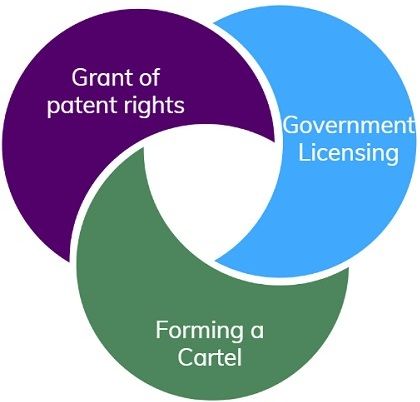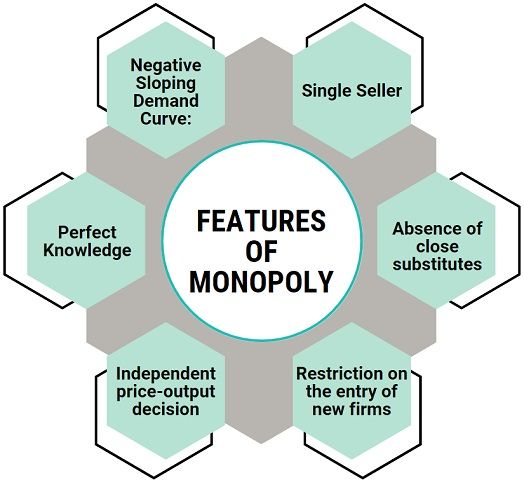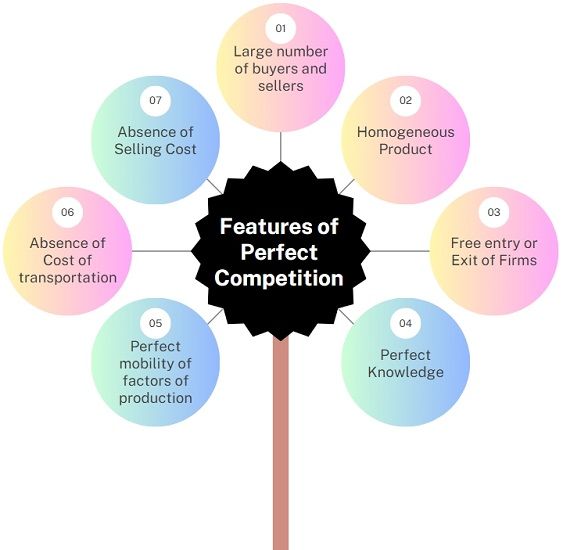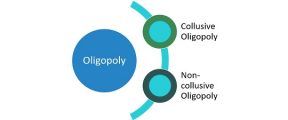 A perfectly competitive market is a market where you can find a large number of buyers and sellers. The firms in such a market offer homogeneous products. Also, no firm is large enough to influence the market price. Basically, perfect competition exhibits the ‘ideal’ form of competition that exists in the industry. For instance: An industry comprising street corner vendors can come under this category.
A perfectly competitive market is a market where you can find a large number of buyers and sellers. The firms in such a market offer homogeneous products. Also, no firm is large enough to influence the market price. Basically, perfect competition exhibits the ‘ideal’ form of competition that exists in the industry. For instance: An industry comprising street corner vendors can come under this category.
On the other hand, a monopoly is when a single firm owns all or almost all of the market for a specific category of product or service. In such a situation, there is a lack of competition, which leads to high prices of goods and services. In a monopoly, the firm has market power, i.e. the ability to restrict output and fix prices with the aim of maximizing profit.
Meaning of Market
A market implies a place or arrangement where buyers and sellers come in contact with each other to perform transactions of buying and selling goods and services. It can be a regional, national or international market.
Meaning of Market Structure
Market structure implies the structure of the market on which the pricing and output decision of the firm is based.
Also Read: Difference Between Market and Industry
Content: Monopoly Vs Perfect Competition
Comparison Chart
| Basis for Comparison | Monopoly | Perfect Competition |
|---|---|---|
| Meaning | Monopoly is such a market situation, where only one seller exists in the market. Hence, there is no competition and so the seller controls the supply and price. | Perfect Competition implies fair and direct competition between the sellers. |
| Supply | As there is just one seller. So, the supply of goods is controlled by him. | As there are a large number of sellers, a single seller cannot control the supply. |
| Demand | Inelastic Demand | Perfectly Elastic |
| Number of Sellers | One | Many |
| Nature of Product | No close substitutes for the product. | The product offered by different sellers is homogeneous in all respects. |
| Entry and Exit | There are restrictions on entry and exit. Therefore a firm can make abnormal profits and losses in the long run. | The firm is free to enter and exit the market. Hence, it results in the absence of abnormal profits and losses in the long run. |
| Price | The firm is a price-maker. So, the firm and industry are one and the same thing. Monopolist charges different prices for different groups of people. | Firms are price-takers. This is because the industry determines the price. The price is determined by demand and supply forces. |
| Level of Knowledge | Buyers and sellers do not possess complete knowledge about the market condition. | Buyers and sellers have perfect knowledge about the market condition. |
| Incurrence of selling cost | Incurred | Not incurred |
| Profit | Firms earn supernormal profit | Firms earn a normal profit |
| Individual producer's share in the market | Low | Complete market share |
| Producer's possibility to reach economies of scale | Low | High |
What is Monopoly?
The term ‘monopoly’ is a combination of two words, i.e. ‘mono‘ which implies ‘single‘ and ‘poly‘ which means ‘single seller‘. It is a condition of the market where only one firm exists for producing and selling a product. Also, there are no close substitutes for that product. Therefore, it rules the entire market.
For Example Indian Railways and Municipal Corporation (for supplying water).
Reasons of Monopoly
- Grant of patent rights: If a company launches a new product or technology, then it usually applies for a patent certificate from the government. This allows the company to enjoy exclusive rights to produce that product. Thus preventing others to produce a similar product using that formula or technology.
- Government Licensing: A monopoly market also comes into being when the government provides a license to a firm, i.e. exclusive rights to produce a particular product or service.
- Forming a Cartel: When firms form a group to set output and prices in a combined manner, then it amounts to a cartel which also exercises monopoly.
Features of Monopoly
- Single Seller: In a monopoly, there is only one seller of the commodity in the market. Hence, the firm constitutes the entire industry. It happens because no other firms can enter the market.
- Absence of close substitutes: As the firm is the sole producer and seller of that product or service, there are no close substitutes.
- Restriction on the entry of new firms: Any other firm apart from the one already existing cannot enter the monopoly market. This happens because of legal or natural barriers to the supply of raw materials, economies of large-scale production, etc.
- Independent price-output decision: As the firm constitutes the entire industry, it is a price maker. Thus, it can have its own price-output policy.
- Perfect Knowledge: It assumes that the monopolist has full knowledge of the market conditions.
- Negative Sloping Demand Curve: The firm sells more output when it reduces the price. Hence, the demand curve is downward sloping from left to right. One more reason for it being downward-sloping is the absence of any close substitute.
Also Read: Difference Between Monopoly and Oligopoly
What is Perfect Competition?
Perfect Competition refers to a market structure wherein a large number of buyers and sellers exist in the market for a particular commodity. In this, the rivalry among individual firms is completely absent.
In these markets, the sellers offer homogeneous products at prevailing market prices. Also, the price is determined by the supply and demand forces. This means that an individual buyer or seller cannot control the price. Every firm operating in the industry sells its output at a certain price.
Moreover, the demand of a single buyer relative to the total market demand is very small. Therefore, no individual buyer can influence the market price. Therefore, each economic agent is called a price taker here.
For Example The agriculture market
Features of Perfect Competition
- Large number of buyers and sellers: Because there are a large number of buyers and sellers, the role of an individual seller is negligible in the determination of price. Hence, the price of the commodity is ascertained by the industry. All the buyers and sellers must accept that price and transact at that price only. This makes the firm price-taker and industry price-maker. Price is fixed as per the market demand and supply forces.
- Homogeneous Product: All the firms operating in the industry produce homogeneous goods. From the consumer’s point of view, the product offered by one firm is similar to that offered by another firm. So, the buyers are indifferent concerning the firms from which they buy the product.
- Free entry or Exit of Firms: Firms can freely enter or exit the market because of no legal or social restrictions. Hence, it is at the discretion of the firm, whether they want to stay in the market or not. Generally, the reason for a firm’s stay in the industry is the profit they earn or the loss they sustain. In a perfectly competitive market, when there is an increase in profit, new firms join the race. and due to the rise in supply, prices of product falls.
- Perfect Knowledge: This market structure relies on the assumption that the buyers and sellers have perfect knowledge about the conditions of the market and also about the price. All the firms have an idea of the price charged by other firms and the technology they use. Hence, each firm makes use of the same technology and charges a similar price. Further, the consumer is fully aware of the prevailing price, the producer knows the cost and the worker is aware of the wage rate paid.
- Perfect mobility of factors of production: Factors of production are perfectly mobile which implies that inputs can easily move from one firm to another and from one industry to another. Hence, it is easy to adjust supply according to the demand.
- Absence of Cost of transportation: It assumes that the purchase of inputs takes place locally. Therefore, the transportation cost is zero.
- Absence of Selling Cost: Selling cost involves the cost of advertising and promoting the product. Hence, uniform price prevails in the market.
Also Read: Difference Between Perfect Competition and Imperfect Competition
Key Differences Between Monopoly and Perfect Competition
- Monopoly is a type of market in which there is only one seller of the product, who is the sole producer and supplier of the product in the market. As against, Perfect Competition is a market structure wherein there are a large number of buyers and sellers that deal with homogeneous products, at a price decided by the market.
- In a monopoly market, there is only one seller who has full-fledged control over the supply. Conversely, in perfect competition, there exists a large number of sellers. Moreover, no individual seller can control the activities of other firms operating in the industry.
- In a monopoly market, there is the absence of any close substitute for the product. So, the product rules the entire market, because of lack of competition from any new or existing product. In contrast, in perfect competition, the product sold by different sellers are homogeneous, so the buyers are willing to buy the product at the same price. Therefore, uniform price prevails in the market.
- In a monopoly market, there are restrictions on entry and exit. Therefore, the firm can earn abnormal profits in the long run. Conversely, in perfect competition, firms are free to enter and exit the market. So, the firms cannot earn abnormal profits or incur abnormal losses in the long run.
- In a monopoly market, the monopolist is the price maker. This is because the firm and industry are one. On the other hand, in perfect competition, the price maker is the industry, whereas the firm is the price taker, as the firms offer homogeneous goods.
- When there is a monopoly market, the buyers and sellers do not have complete knowledge. In contrast, when there is perfect competition, both buyers and sellers have complete knowledge of the market conditions.
- In the case of a monopoly, the demand is inelastic, and so the demand curve slopes downward. As against, in the case of perfect competition, the demand is perfectly elastic. Therefore, the demand curve is a horizontal straight line.
- In a monopoly, the demand curve slopes downward, as more products can be sold only at less price. Conversely, in perfect competition, the demand curve is perfectly elastic, because the price remains the same at various levels.
- In a perfect competition, a firm earns only normal profit, in the long run. Whereas a monopolist earns supernormal profit in the long run.
Conclusion
Above all, in practical life, you can rarely find perfect competition. However, it is important to know the factors which cause deviations from the perfectly competitive market. Moreover, monopoly can be found in a number of sectors at present.









Nawar khan says
nice notes